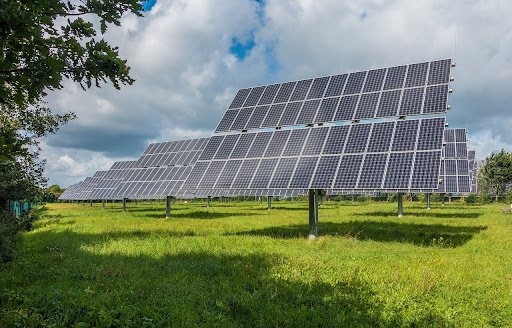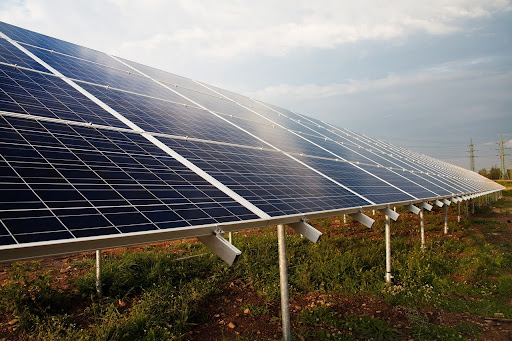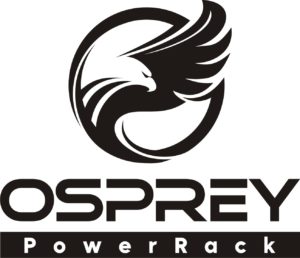Key Takeaways
- A 150kw solar panel system can generate between 600 kWh and 900 kWh of electricity per day.
- The initial cost for installing a 150kw commercial solar system typically ranges from $150,000 to $250,000.
- Government incentives and tax credits can cover more than 30% of installation costs.
- Nuance Energy’s Osprey PowerRACK® is a fast, cost-effective, and scalable solution for commercial setups, with minimal labor requirements and costs.
150kw Commercial Solar Panels
A 150kw solar panel system is designed to meet the energy needs of medium to large commercial establishments. It’s a robust setup that can produce between 600 kWh and 900 kWh per day. This amount of power can cover a significant portion of a business’s energy requirements.
By using solar power, businesses reduce their carbon emissions, contributing to a cleaner and more sustainable environment.
Basic Components of a 150kw Solar System
- Solar Panels: These are the heart of the system, capturing sunlight and converting it into electricity.
- Inverters: These devices convert the direct current (DC) produced by the panels into alternating current (AC), which is used by most appliances.
- Mounting Structures: These secure the panels in place on rooftops or the ground.
- Electrical Wiring: This ensures the transmission of electricity from the panels to the inverters and then to the building’s electrical system.
| Nuance Energy is your superior solution for Ground Mount solar. Our patented foundation technology Osprey PowerRACK® allows for rapid installation using only handheld tools, significantly reducing both time and costs compared to traditional racking systems. This cutting-edge technology works for residential and commercial installations, and Nuance Energy empowers solar installers to take back control of their installation schedules, control project COGS, gain market share, increase the speed of installation, and reduce the cost of labor. In contrast, a traditional ground mount is much more unpredictable, slower, and costly.
Find out how Nuance Energy can accelerate your solar projects with the Osprey PowerRACK® line, and boost your profitability. Contact us today to discuss our innovative ground-mount solutions. |
Cost Analysis of 150kw Commercial Solar Panels

A 150kW solar panel system can produce around 27,144 kWh of electricity each month.
Initial Installation Costs
The installation cost for a 150kw solar panel system typically ranges between $150,000 and $250,000. This price includes:
- Cost of solar panels and inverters
- Installation labor and materials
- Permitting and inspection fees
Businesses can significantly cut down on these initial expenses by opting for alternative set-ups like Nuance Energy’s Osprey PowerRACK®. This offers significantly lower setup costs by eliminating the need for concrete and heavy machinery. Its easy installation with basic tools cuts labor expenses, making it a cost-effective choice for commercial solar projects.
Maintenance and Operational Costs
While solar systems are generally low-maintenance, regular inspections and cleaning are necessary to ensure optimal performance. Dust and debris can accumulate on panels, reducing their efficiency. Additionally, inverters, a critical component of the system, may require replacement every 10-15 years.
Some companies offer maintenance packages that can help manage these costs effectively.
Financing Options for Commercial Solar Installations
Lease vs Purchase
Leasing allows businesses to use solar panels without the upfront costs of purchasing – instead, they pay a fixed monthly fee. This can be beneficial for businesses that want to conserve capital or lack the funds for a full purchase. However, they may not be eligible for certain tax incentives.
On the other hand, purchasing the system outright can be more cost-effective in the long run. Owners can take advantage of tax credits and incentives, and eventually, the system will pay for itself.
Solar Loans: Benefits and Drawbacks
Benefits of solar loans include:
- Ownership of the solar system and eligibility for tax credits
- Fixed monthly payments, similar to a mortgage
- Potentially lower interest rates compared to other financing options
However, it’s essential to be aware of potential drawbacks, such as interest payments that increase the total cost over time.
Incentives
In addition to the Federal Investment Tax Credit (ITC), there are several other incentives available in the U.S. to encourage the adoption of solar energy systems, including state, local, and utility-specific programs.
| Incentive | Description | Eligibility |
| Federal ITC | 30% tax credit on installation costs | Commercial and residential systems |
| Domestic Manufacturing Bonus Credits | Additional 10% tax credit | Commercial projects that meet certain domestic content requirements |
| State Incentives | Varies by state; includes rebates | State-specific criteria |
| Accelerated Depreciation (MACRS) | Accelerated depreciation for solar systems | Commercial solar systems |
| USDA REAP Grant | Grants for rural renewable projects | Rural small businesses |
| Net Metering | Credits for excess electricity sent back to the grid | Eligibility criteria vary by state and utility |
Alternative Technologies and Customization Options
Exploring Battery Storage Solutions
Batteries store excess energy generated during the day, which can be used during nighttime or cloudy periods. This ensures a continuous power supply and further reduces reliance on the grid.
While battery systems add to the initial cost, they provide greater energy independence and resilience, especially in areas prone to power outages.

Integrating solar with the grid enables businesses to sell excess power, reducing energy costs through net metering.
Integration with Existing Power Grids
Integrating a solar system with the existing power grid allows businesses to sell excess electricity back to the grid. This process, known as net metering, can provide additional savings by offsetting energy costs.
Businesses should consult with their utility provider to understand the net metering policies in their area.
Custom Solar Panel Configurations
Custom configurations may include different panel types, mounting options, and system sizes. Working with experienced solar installers can help businesses design a system that optimally balances cost, efficiency, and space considerations, ensuring the best return on investment.
Post-Installation Monitoring and Optimization

Monitoring and regular maintenance are essential for consistent energy production in commercial solar racking systems.
Once the solar system is installed, ongoing monitoring and optimization are essential to maintain peak performance. Monitoring systems track the energy production and detect any issues that may arise.
Routine maintenance should include cleaning the panels, checking electrical connections, and inspecting the inverters.
Why Is Nuance Energy’s Osprey PowerRACK® a Good Choice for Commercial Set-Ups?
- Fast Installation: The Osprey PowerRACK® enables same-day installation, significantly reducing project timelines and allowing faster revenue recognition.
- Lower Labor Costs: Installation with basic hand-held tools eliminates the need for specialized labor or heavy machinery, cutting labor costs by up to 73%.
- Adaptability to Terrain: The system is designed for all types of terrain, including rocky or uneven ground.
- Scalability: Osprey PowerRACK® can be used in both small and large commercial installations.
- Minimal Site Preparation: There is no need for concrete or extensive land preparation, reducing upfront costs and allowing installation in a wide range of conditions.
- Durability: Our earth anchor foundation provides long-term stability, withstanding harsh weather conditions like high winds, frost heave, and permafrost.
- Easier Maintenance: Ground-mount panels with accessible design make maintenance and cleaning simpler.
- Environmental Sustainability: The concrete-free, minimally invasive installation reduces environmental impact, preserving the natural landscape.
- Predictable Costs: The absence of geotechnical reports and heavy equipment ensures more predictable project costs.
Ready to take the next step?
Get in touch for a quote on your upcoming project and schedule a site assessment.
Frequently Asked Questions
How much space is needed for a 150kw solar panel setup?
A 150kw solar panel system typically requires around 8,000 to 10,000 square feet of space. The exact area depends on the efficiency and size of the panels used. Ground-mount systems may need more space compared to rooftop installations. It’s important to ensure that the available space is free from obstructions and receives ample sunlight throughout the day.
Are there any government incentives available?
Yes, there are several government incentives available for businesses investing in solar energy. The federal Investment Tax Credit (ITC) allows businesses to deduct 30% of their solar installation costs from their federal taxes. Additionally, many states offer rebates, grants, and other financial incentives to encourage the adoption of solar energy.
What is the average payback period for a commercial solar system?
The payback period for a commercial solar system can vary depending on factors such as installation costs, energy savings, and available incentives. On average, businesses can expect to recoup their investment in 5 to 10 years. However, with rising electricity prices and the potential for additional savings through net metering, the payback period can be shorter.
What is a cost-effective solar racking system for commercial set-ups?
Nuance Energy’s Osprey PowerRACK® is a highly cost-effective solar racking system for commercial setups. Its concrete-free earth anchor technology reduces installation time and labor costs by up to 73%. The system is scalable, adaptable to various terrains, and easy to install with basic handheld tools.
Save Time & Money on Your Next Solar Project
Request a QuoteRECENT POSTS
- DPW Solar vs Nuance Energy Mounted Solar Options: Cost & Benefits
- Geotechnical Report Cost & Requirements For Solar Projects
- Are Solar Panels Worth It In Nevada? Costs & Options
- OSPREY PowerRack Ground Mount System Compatibility: Single- and Dual-Axis Trackers
- Rammed Earth Foundation For Solar Arrays: Cost, Pros & Cons
- Agrivoltaics Explained: Solar & Agriculture Combined
- Large Scale Solar Systems Options: Pros & Cons
- Best Solar Options For Farms & Agriculture: Cost, Pros & Cons
- Unirac vs MT Solar Mounted Options: Cost & Benefits
- IronRidge vs Grengy Mounted Solar Options: Cost & Benefits

